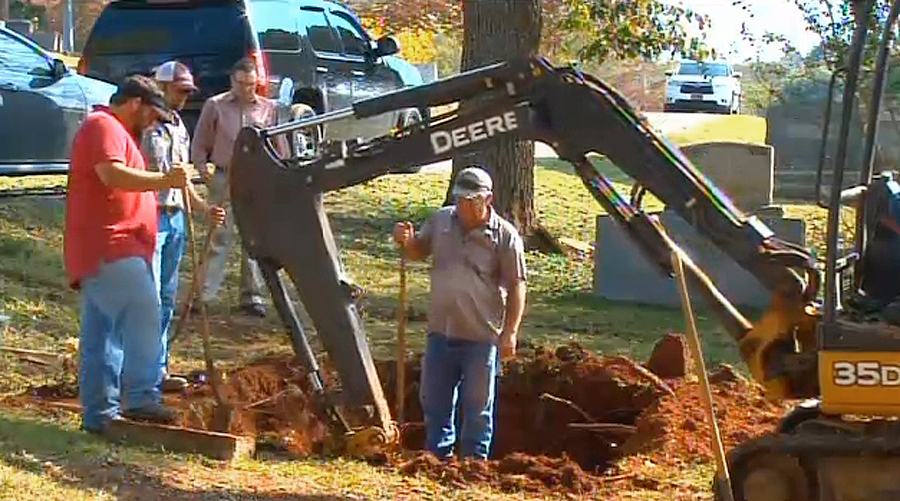 Workers labor to exhume the body of a John Doe buried in 1981 in Scottsboro, Ala. The FBI is exhuming the body in its search for a 10 Most Wanted Fugitive accused of killing his family with a sledgehammer nearly 40 years ago. In court filings, the FBI said there is a strong resemblance between photos of the John Doe and former State Department diplomat William Bradford "Brad" Bishop Jr.
Workers labor to exhume the body of a John Doe buried in 1981 in Scottsboro, Ala. The FBI is exhuming the body in its search for a 10 Most Wanted Fugitive accused of killing his family with a sledgehammer nearly 40 years ago. In court filings, the FBI said there is a strong resemblance between photos of the John Doe and former State Department diplomat William Bradford "Brad" Bishop Jr.The FBI will use DNA from a decades-old cigarette butt in its quest to determine whether a body exhumed from an Alabama grave is one of its top 10 most-wanted fugitives, authorities said Friday.
The cigarette butt was collected as authorities investigated William Bradford "Brad" Bishop Jr., Scottsboro police Lt. Scott Matthews said.
Bishop was accused of using a sledgehammer to kill his wife, mother and three sons in their Bethesda, Maryland, home in 1976.
Authorities later found the bodies burned in North Carolina. Bishop's station wagon was found parked in the vast Great Smoky Mountains National Park south of Gatlinburg, Tenn.
Authorities have found no trace of Bishop since then.
On Thursday, the body of an unknown hitchhiker who had been killed by a vehicle in 1981 was exhumed from a grave in Scottsboro.
It was a tip from an Alabama man, Jeremy Collins of Scottsboro, that led to the gravesite.
"We wouldn't have been there without him," said Paul Daymond, an FBI spokesman in Alabama.
Renewed interest in the decades-old events in Maryland and Alabama began about a year ago, when Matthews took an interest in trying to identify the unknown hitchhiker killed along a highway in his town in 1981.
"There's a family out there somewhere that's missing someone," Matthews said.
"My thought was with social media as it is today, if we could get the story out there again, it would grow legs, it would travel."
Police found no identification on the hitchhiker, and he was only carrying one thing - a phone number written on a piece of paper, said Keith Smith, who was Scottsboro's police chief at the time of his death. It turned out to be a truck driver who had picked up the hitchhiker at one point, Smith said.
The lead didn't produce enough information to identify the man who came to be known only as John Doe, and the case grew cold.
Matthews' efforts to renew interest in the case resulted in a story in the local newspaper, the Daily Sentinel. Then, in July, his case was featured on the CNN program "The Hunt with John Walsh."
Both would prove critical in connecting the hitchhiker's death to the hunt for Bishop.
Collins watched the TV program and noticed striking similarities between Bishop's picture and the photo of the hitchhiker he had seen earlier, when Matthews and his colleagues publicized their old case.
Collins called police in Scottsboro, who then relayed the tip to Maryland authorities investigating the Bishop case.
Bishop was described as "a highly intelligent" former U.S. Department of State employee when the FBI added him to its Ten Most Wanted List in April.
In Bishop's wanted poster, the FBI calls him an avid outdoorsman, camper and hiker who was prone to violent outbursts.
Now, the FBI has several ways to determine if Bishop is the John Doe. Along with the DNA from the cigarette butt, the FBI has detailed dental X-rays from an exam performed on Bishop in 1972, according to records released by the agency.
The FBI also has a set of fingerprints from the U.S. Army, where Bishop had enlisted in August 1959.
The process of identification could take a few weeks, Matthews said.
If it turns out that the hitchhiker is not Bishop, Matthews said he will continue trying to learn the man's identity.
"You would think still a brother, a sister, a niece or a nephew might come forward," he said. "I'm not going to give up."
